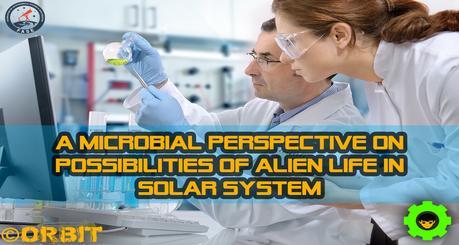 With recent findings, microbial diversity found to thrive at 6.7 km depth inside the Earth's crust, deep trenches in the ocean with pressures exceeding 110 Mpa, extreme pH conditions varying from 0 to 12.8, and temperature gradient from freezing -22 C to hydro-thermal vents of 122 C dramatically expanded boundaries of habitable environmental conditions leading to possibilities of finding life in various planets in the solar system and supports Panspaermia hypothesis, the migration of life throughout the space.
With recent findings, microbial diversity found to thrive at 6.7 km depth inside the Earth's crust, deep trenches in the ocean with pressures exceeding 110 Mpa, extreme pH conditions varying from 0 to 12.8, and temperature gradient from freezing -22 C to hydro-thermal vents of 122 C dramatically expanded boundaries of habitable environmental conditions leading to possibilities of finding life in various planets in the solar system and supports Panspaermia hypothesis, the migration of life throughout the space. Microbes which thrive on extreme environments are known as extremophiles and further classified according to the environmental niches. Extreme Thermophiles are microorganisms which can thrive on high temperatures above 80 C. Methanopyrus kandleri, a chemoautotrophic anaerobe community found in deep sea hydrothermal vents which can survive and reproduce at 122 C. These microbes exhibit many adaptations to prevent denaturation and degradation of their plasma proteins and nucleic acids. Psychrophiles are the opposites of thermophiles which have optimum temperatures on sub zero level environments from stratosphere to the polar ice caps. Cold adapted enzymes having high specific activities at low temperatures, activity of anti freeze proteins and increased levels of unsaturated fatty acids can find on these cold loving microorganisms. Acidophiles and Alkaliphiles are the exteremophiles located on the extreme ends of the pH scale of the environment. They mainly maintain intercellular pH levels via active transport. Piezophiles are microorganisms that grow on elevated atmospheric pressure conditions up to 110 Mpa. However difficulty of sample acquisition and simulation in laboratories has somewhat conspired the research on these microbial communities.
With current knowledge of extraterrestrial environments in the planets of the solar system it's obvious that many appears to susceptible to sustain life similar to the extreme environments on earth. As far as we know with present data Martian surface is not supportive for life. However regions such as Meridiani Planum and southern highlands represent environmental conditions similar to Atacama Desert, the Antarctic Dry Valleys, the Rio Tinto region, and the deep basalt aquifers. Widespread chloride deposits, endolithic habitats on the basaltic rocks may harbor life powered by chemoautotroph similar to the eco systems found on earth. One of the very intriguing discovery about the Martian atmosphere is the trace amounts of methane which is highly unstable. Roughly its estimated annual production of methane is 270 tons and this phenomenon is highly unlikely due on volcanism or hydro-thermal activity. The exact source is still remaining as a mystery and it could a bi product of a life form such as methanogene.
Europa, one of the four major moons of Jupiter presents an internal structure consists primarily with silicate rock and iron core with presence of subsurface ocean about 100 km thick covered with ice crust. The dynamic activity of the on the surface clearly indicate the tidal forces deep sea vents beneath and possible life on sub glacial ocean. Lake Vostok in Antarctica is the largest and deepest known subglacial lake and 3623m drilling were required to penetrate the ice cover for paleoclimate studies. This lake represent possible analog to Europa's environment and the life of the Vostok Lake sustain life with symbiotic relationships which involve lithoautotrophic microorganisms that use chemical energy to support metazoans without photosynthesis. In addition the outer ice crust which is estimated to 20-30km thick protects the inner ocean from the Jovian and solar radiation exposure.
Previous paradigms about the evolution and existence of life have changed with the studies on extreme environmental conditions. Still large number of species and on deep subocean and subterranean regions remain unknown to science. The inspiration suggest that many places of the solar system supports life which previously thought to be inhabitable such as Venus, Enceladus, Io, Titan, and cerus. The exploration just initiated and more fascinating discoveries on near future would change the contemporary dimension on nature of life.
Extracted from The ORBIT Magazine - 2015
The ORBIT Magazine - 2015
An Astronomical Magazine that published by
Astronomy & Space Science Association of
D.S.Senanayake College, ColomboA GUEST ARTICLE
 Janith Weerasinghe Janith WeerasingheEditor Foundation of Astronomical Studies & Exploration (FASE)  |
2. Madigan, M.T.; Martino, J.M. Brock Biology of Microorganisms, 11th ed.; Pearson Education: Upper Saddle River, NJ, USA, 2006.
3.Daniel, R.M.; Cowan, D.A. Biomolecular stability and life at high temperatures. Cell. Mol. Life Sci. 2000, 57, 250-264.
4.Takai, K.; Nakamura, K.; Toki, T.; Tsunogai, U.; Miyazaki, M.; Miyazaki, J.; Hirayama, H.; Nakagawa, S.; Nunoura, T.; Horikoshi, K. Cell proliferation at 122 °C and isotopically heavy CH4 production by a hyperthermophilic methanogen under high-pressure cultivation. Proc. Nat. Acad. Sci. USA 2008, 105, 10949-10954.
5.Nichols, D.; Miller, M.R.; Davies, N.W.; Goodchild, A.; Raftery, M.; Cavicchioli, R. Cold adaptation in the Antarctic archaeon, Methanococcoides burtonii, involves membrane lipid unsaturation. J. Bacteriol. 2004, 186, 8508-8515
6.Baker-Austin, C.; Dopson, M. Life in acid: pH homeostasis in acidophiles. Trends Microbiol. 2007, 15, 165-171.
7. McKay, C.P.; Andersen, D.T.; Pollard, W.H.; Heldmann, J.L.; Doran, P.T.; Fritsen, C.H.; Priscu, J.C. Polar lakes, streams, and springs as analogs for the hydrological cycle on Mars. In Water on Mars and Life; Tokano, T., Ed.; Springer: Berlin, Germany, 2005.
8. Squyres, S.W.; Grotzinger, J.P.; Arvidson, R.E.; Bell, J.F.; Calvin, W.; Christensen, P.R.; Clark, B.C.; Crisp, J.A.; Farrand, W.H.; Herkenhoff, K.E.; Johnson, J.R.; Klingelhöfer, G.; Knoll, A.H.; McLennan, S.M.; McSween, H.Y; Morris, R.V.; Rice, J.W.; Rieder, R.; Soderblom, L.A. In situ evidence for an ancient aqueous environment at Meridiani Planum, Mars. Science 2004, 306, 1709-1714.
9. Formisano, V.; Atreya, S.; Encrenaz, T.; Ignatiev, N.; Giuranna, M. Detection of methane in the atmosphere of Mars. Science 2004, 306, 1758-1761.
10. Kuskov, O.L.; Kronrod, V.A. Internal structure of Europa and Callisto. Icarus 2005, 177, 550-556.
11. Greenberg, R.; Geissler, P.; Hoppa, G.; Tufts, B.R. Tidal-tectonic processing and their implications for the character of Europa’s icy crust. Rev. Geophys. 2002, 40, 1-33.
12. Marcos, R.F.; Nissar, A. Possible detection of volcanic activity on Europa: Analysis of an optical transient event. Earth Moon Planets 2000, 88, 167-175.
13. Siegert, M.J.; Ellis-Evans, J.C.; Tranter, M.; Mayer, C.; Petit, J.; Salamatin, A.; Priscu, J.C. Physical, chemical, and biological processes in Lake Vostok and other Antarctic subglacial lakes. Nature 2001, 414, 603-609.
14. Paranicas, C.; Mauk, B.H.; Khurana, K.; Jun, I.; Garrett, H.; Krupp, N.; Roussos, E. Europa’s nearsurface radiation environment. Geophys. Res. Lett. 2007, 34, doi:10.1029/2007GL030834.
15. Rampelotto, P.H. Resistance of Microorganisms to Extreme Environmental Conditions and Its Contribution to Astrobiology.Sustainability2010,2, 1602-1623.
